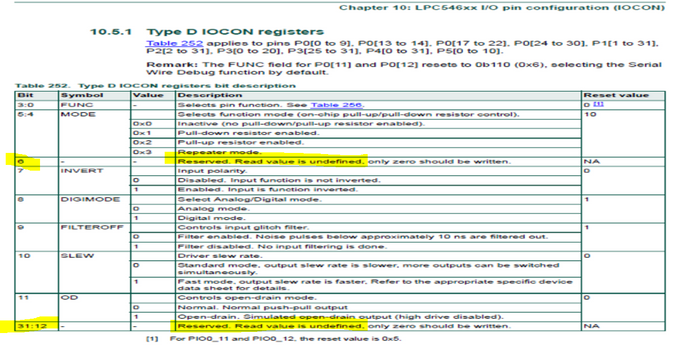- Forums
- Product Forums
- General Purpose MicrocontrollersGeneral Purpose Microcontrollers
- i.MX Forumsi.MX Forums
- QorIQ Processing PlatformsQorIQ Processing Platforms
- Identification and SecurityIdentification and Security
- Power ManagementPower Management
- Wireless ConnectivityWireless Connectivity
- RFID / NFCRFID / NFC
- Advanced AnalogAdvanced Analog
- MCX Microcontrollers
- S32G
- S32K
- S32V
- MPC5xxx
- Other NXP Products
- S12 / MagniV Microcontrollers
- Powertrain and Electrification Analog Drivers
- Sensors
- Vybrid Processors
- Digital Signal Controllers
- 8-bit Microcontrollers
- ColdFire/68K Microcontrollers and Processors
- PowerQUICC Processors
- OSBDM and TBDML
- S32M
- S32Z/E
-
- Solution Forums
- Software Forums
- MCUXpresso Software and ToolsMCUXpresso Software and Tools
- CodeWarriorCodeWarrior
- MQX Software SolutionsMQX Software Solutions
- Model-Based Design Toolbox (MBDT)Model-Based Design Toolbox (MBDT)
- FreeMASTER
- eIQ Machine Learning Software
- Embedded Software and Tools Clinic
- S32 SDK
- S32 Design Studio
- GUI Guider
- Zephyr Project
- Voice Technology
- Application Software Packs
- Secure Provisioning SDK (SPSDK)
- Processor Expert Software
- Generative AI & LLMs
-
- Topics
- Mobile Robotics - Drones and RoversMobile Robotics - Drones and Rovers
- NXP Training ContentNXP Training Content
- University ProgramsUniversity Programs
- Rapid IoT
- NXP Designs
- SafeAssure-Community
- OSS Security & Maintenance
- Using Our Community
-
- Cloud Lab Forums
-
- Knowledge Bases
- ARM Microcontrollers
- i.MX Processors
- Identification and Security
- Model-Based Design Toolbox (MBDT)
- QorIQ Processing Platforms
- S32 Automotive Processing Platform
- Wireless Connectivity
- CodeWarrior
- MCUXpresso Suite of Software and Tools
- MQX Software Solutions
- RFID / NFC
- Advanced Analog
-
- NXP Tech Blogs
Hi, I have a simple question. giving that only 0 can be written in bit number 6 and 12to 31, and reading value is undefined. So to set the function value to 0001 I cannot write
IOCON->PIO[0][0]= (IOCON->PIO[0][0] & (~(0b1111))) |0001 .
the reason for that when I read bit number 6 or 12 to 31 there is a chance that on of these bits will return .1 so in this case I write 1 to the bit that returned 1 instead of 0 which is not right. instead I need to have a mask that will always clear bit number 6 and 12 to 31.
ex
IOCON->PIO[0][0]= (IOCON->PIO[0][0] & 0b101110110000)| 0001
in case of type I the mask that will always clear bit 12 to 31. in case of type A the mask will always clear bit 6, 10, 12 to 31.
and giving that each type are different, the mask that will be used to set the Function for the pin will be different based on the pin type D,I, or A.
AM I right?? or should I not put that much concern, that reading bits such as bit 6 in type D can return undefined value(so it could be 1)? thanks very much in advance
已解决! 转到解答。
> my question what if any of the value we read for pin 6, 12 to 31 was 1(because the reading value is undefined). in this case we wrote 1 in bit 6, or 12 to31. and we should only write zero to theses bits according to data sheet.
> is this a mistake in SDK, or in datasheet? or did I miss something?
Vendor-supplied examples often assume a "sunny-day scenario", i.e. bravely skip most error checking, or ignore such undefined values. Level of testing is often minimal.
Thus, probably more or less "lazy coding".
I wouldn't speculate. If bits are documented as "reserved", I would avoid writing any other value as specified to them.
Those "registers" are just the interface according to the documented programming model, you don't know what is actually behind it (i.e. on the silicon). Might be just register bits, or but might be peripheral gates that affect the unit immediately.
And, later MCUs might make use of reserved bits, giving you portability issues.
Hi, Thanks for your response and I agree with you. However, in the SDK I saw the following
so pin 1 in GPIO 1 is D typed
so IOCON type D says that reading bit number 6 and 12 to 31 is undefined (could be 0 or 1?).
so the following part of the code will be clearing the bits that is related to func_MASK and DIGIMODE_mask(first four bits and bit number
((IOCON->PIO[1][1] &
/* Mask bits to zero which are setting */
(~(IOCON_PIO_FUNC_MASK | IOCON_PIO_DIGIMODE_MASK)))
after making or with the desired value for FUNC and DIGIMODE this new value will be writing to the
IOCON->PIO[1][1]
which include the read value for pin6, 12 to 31
my question what if any of the value we read for pin 6, 12 to 31 was 1(because the reading value is undefined). in this case we wrote 1 in bit 6, or 12 to31. and we should only write zero to theses bits according to data sheet.
is this a mistake in SDK, or in datasheet? or did I miss something?
Thank you !
> my question what if any of the value we read for pin 6, 12 to 31 was 1(because the reading value is undefined). in this case we wrote 1 in bit 6, or 12 to31. and we should only write zero to theses bits according to data sheet.
> is this a mistake in SDK, or in datasheet? or did I miss something?
Vendor-supplied examples often assume a "sunny-day scenario", i.e. bravely skip most error checking, or ignore such undefined values. Level of testing is often minimal.
Thus, probably more or less "lazy coding".




